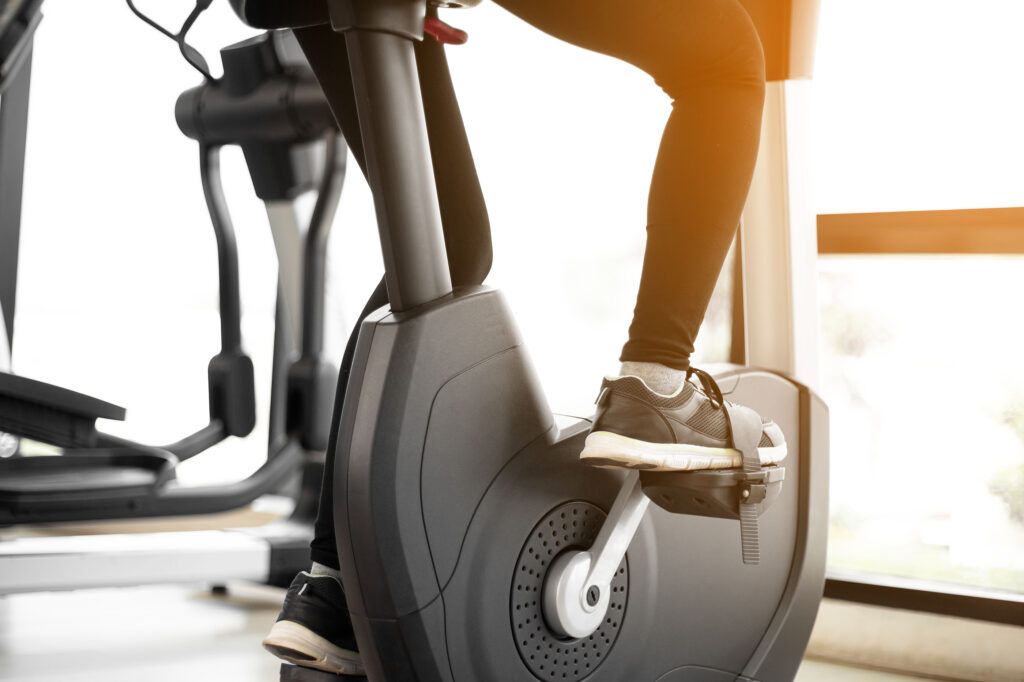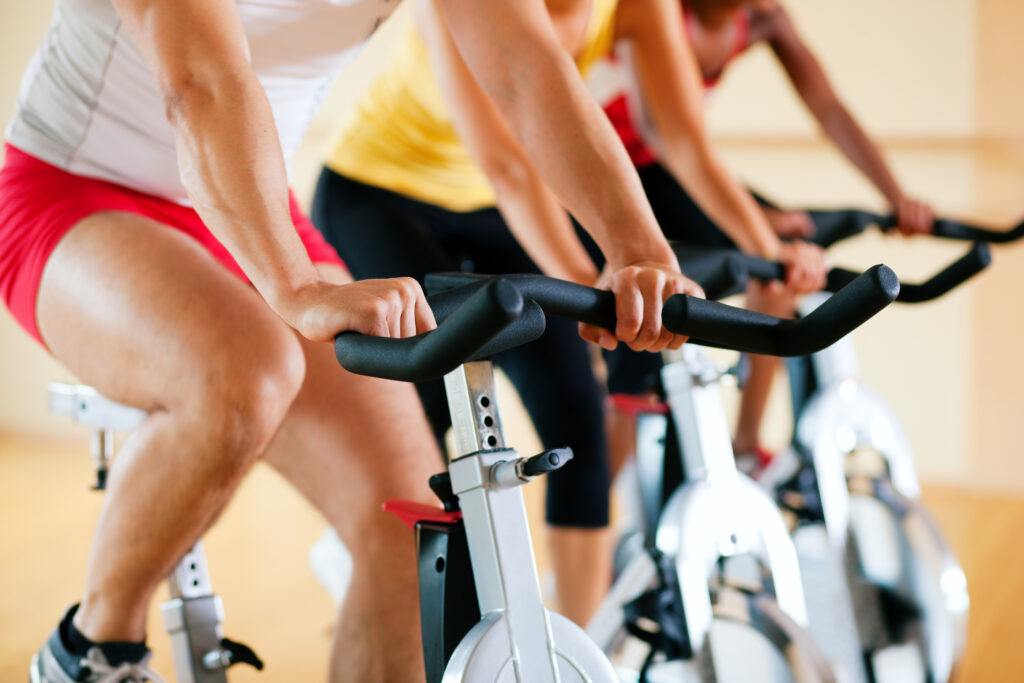Exercise bikes can make a great addition to any home gym because they’re compact, effective, and usually fairly affordable (although with streaming cycles this last one isn’t always the case).
One of the keys to being happy with your bike though, is deciding on the right style to begin with.
In other words, knowing what to expect is a great way to avoid disappointment.
These days, spin bikes (formally known as indoor cycles) are getting most of the attention, but let’s be real- these cycles aren’t for everyone.
And even though we don’t see ’em on tv anymore, traditional upright bikes are still around and they can still be quite effective when it comes to getting a nice cardio workout in.
If you’re certain a recumbent bike isn’t for you, you may be stuck choosing between an upright bike and a spin bike- and if this is the case, you’ve come to the right place.
In this guide, I’ll go over all the differences between upright bikes and spin bikes, including who I think each style would be best suited for.
After reading, you’ll know everything you need to in order to choose the right type of bike for your home.
| Upright Bikes | Spin Bikes | |
|---|---|---|
| Resistance | Usually magnetic Lighter flywheels (30 lb or less) | Magnetic or friction brake Heavier flywheels (up to 50+ lb) |
| Seats | Larger, softer, more comfortable | Smaller, firmer, less comfortable |
| Handlebars | Usually higher, multi-grip | Usually sit a little lower, multi-grip, adjustable |
| Features | Consoles Built-in workouts Bluetooth Heart rate monitoring Cooling fans Toe cage pedals | Consoles Built-in workouts Bluetooth Heart rate monitoring Cooling fans Toe cage or cleat compatible pedals |
| Price | All budgets | All budgets |
| Best suited for | Folks looking for more comfortable bike | Folks looking to mimic feel of riding outdoors, intense workouts |
Upright Bikes vs Spin Bikes
Technically speaking, traditional upright (or stationary bikes) and spin bikes (indoor cycles) are both “upright” exercise bikes because you’re sitting vertically on both.
This is opposed to a recumbent bike where you are sitting in a more horizontal position- hence the name “recumbent”, which means reclined.
Semantics aside, you can get a great workout on either style of bike, but if you’re looking for higher intensity workouts, a spin bike is the better option.
But I’m getting ahead of myself.
Let’s start with a rundown on the key characteristics of each style first.
Upright Bikes

These are the old school bikes a lot of us probably picture when we think of an exercise bike in a commercial gym.
Upright bikes are great because they put you in a more traditional bike riding position, but they’re still a little more comfortable than going all-in with a spin bike.
Upright bikes usually have larger, more cushiony (is that a word?) seats, which are more comfortable to sit on than those found on spin bikes.
They also have consoles and handlebars that are usually set a little higher, so you don’t find yourself leaning forward as much as you do with a spin bike.
This more vertical positioning could be more comfortable for folks with questionable backs.
That said, upright bikes are still lacking a backrest, so if you’re dealing with an achy back, a recumbent bike might be the safest bet for ya.
Anyway, uprights are a little more comfortable than spin bikes, but there are differences in the way they perform too.
Pretty much all upright bikes are going to use magnetic resistance systems, but the weight of their flywheels can vary greatly.
Spin bikes are known for having very heavy flywheels, but upright bikes aren’t.
That doesn’t mean you can’t find a nice upright bike with a heavy flywheel, but what’s considered heavy for an upright would be considered pretty average for a spin bike.
Upright flywheels rarely weigh more than 30 lb and even then, there aren’t that many packing that much muscle.
Spin bikes on the other hand, come with flywheels weighing up to 50 lb and more.
Upright bikes tend to come with consoles that come with plenty of built-in workouts to choose from and the other console features can vary depending on the price and quality of the upright bike.
Other common features to look for include bluetooth compatibility with fitness apps, heart rate monitoring, tablet holders, water bottle holders, and whatnot.
We don’t hear as much about upright bikes having streaming capabilities, but there are a few out there (like NordicTrack’s Commercial VU series).
In terms of compactness, there isn’t much difference between uprights and spin bikes- both have a very small footprint.
Overall, upright bikes are nice because they offer a good combination of comfort and performance. Uprights bikes would make a good option for folks who are looking for a solid workout experience, but while staying fairly comfortable too.
Spin Bikes

Spin bikes are crazy popular these days.
We’re constantly seeing commercials on tv for all the high-end streaming cycles and it feels like new spin bikes are coming out like every day.
There are a ton of spin bikes to choose from, regardless of price range, so if you think a spin bike is the right option for ya, you shouldn’t have any issues finding one that fits your budget.
Spin bikes, unlike upright bikes, are designed first and foremost to replicate the feel of riding a road bike.
This is why these bikes were created in the first place- to help cyclists train indoors, year ’round regardless of weather or road conditions.
With this in mind, the way spin bikes look and feel will make a lot more sense.
Since these cycles are designed to mimic road bikes, they will be significantly less comfortable than upright bikes to sit on.
This is because spin bikes usually come with traditional road seats, which are hard, small, and pretty uncomfortable for the uninitiated (don’t worry, your bum will adjust with time).
Spin bikes usually come with handlebars that are a little lower on the frame too, allowing you to lean forward more during rides like you would if you were riding a bike outdoors.
In terms of performance, spin bikes are designed to provide intense workouts.
This means heavy flywheels, heavy resistance, and the ability to reach high cadences.
When it comes to the resistance, spin bikes can use either a friction brake or a magnetic resistance system, depending on the price range you’re looking in.
Each type of resistance has its benefits, but magnetic systems are better because they’re smoother and they don’t require the need to replace a brake pad periodically.
I mentioned earlier that spin bike come with heavier flywheels. This is usually the case because the heavier flywheels build more momentum, which improves the smoothness of the pedal action.
Spin bikes will usually come with fully adjustable seats (or at least the good ones will), which means you can adjust both the height and the horizontal (fore/aft) position.
Some upright bikes will come with a fully adjustable seat, but many won’t.
Many will also come with fully adjustable handlebars, but this feature isn’t quite as common.
When it comes to features, it all depends on the price and quality of the bike.
Some spin bikes come with advanced, HD touchscreen consoles while others don’t come with a console at all.
Other features to consider include bluetooth compatibility, heart rate monitoring, cleat compatible pedals, and workout programs.
Overall, spin bikes are best suited for people who don’t have many mobility or joint issues and are looking for a bike that can provide intense workouts.
Final Thoughts
Regardless of which style of exercise bike you end up going with, rest assured you can get a great workout on both.
Upright bikes are a better option for folks looking for a little more comfort from their bike and who don’t necessarily need as much intensity.
Spin bikes, on the other hand, are best suited for folks who are looking to replicate the feel of riding a road bike and who are interested in doing higher intensity workouts.
Spin bikes tend to be a little harder on the knees and ankles, with the higher resistances and higher speeds, so if you have joint problems, this is something to keep in mind.
The great thing is that upright and spin bikes are both compact and they both come in all price ranges, so regardless of you’re living situation or budget, you should still be able to find a bike to fit your needs.
Well, that about does it.
I hope you found this guide helpful. As always, if there are any questions or comments, feel free to leave ’em below.
And if you need any extra info, feel free to check out my upright bike guide or my spin bike guide for more information on either type of bike.




